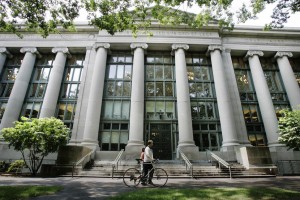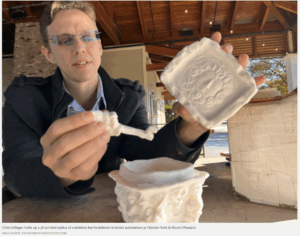Harvard Law School officials are reviewing the use of the school’s seal, which displays part of the crest of a slaveholding family.

A bicyclist walks by Langdell Hall, the Harvard Law Library, on the campus of the Harvard Law School in Cambridge, Mass., Monday, Aug. 1, 2005. (AP Photo/Charles Krupa)
The school’s seal includes three bushels of wheat, which also appears on the coat of arms for the family of Isaac Royall, a slaveholder who left part of his estate to Harvard to help found the law school.
The law school is among a number of other American universities that are evaluating their historical connections to the slave trade.
Harvard Law School Dean Martha Minow announced a committee on Monday to research the symbol and if the school should change the crest.
“Symbols are important,” Minow said. “They become even more important when people care about them and focus on them.”
The committee is expected to make a recommendation in March.
The scrutiny over the seal took hold when a group of students created a Facebook page in October called “Royall Must Fall” to bring attention to what the crest represents.
Modelling their movement after a student movement at the University of Cape Town in South Africa to remove an image of Cecil Rhodes, a British imperialist, from the campus, the Harvard Law student called for the removal of the Royall coat of arms.
The students posted a picture of the crest replacing the bushels of wheat with images of people carrying the bushels on their backs.
The Royall family, whose estate can still be visited today, was the largest slaveholding family in Massachusetts. Royall’s father was also known to be a cruel slave owner. According to the letterstudents wrote to Minow, he was responsible for burning 77 slaves alive and torturing and murdering others.
“Harvard Law School was founded on the exploited labor, broken bones, and ashes of enslaved human beings,” the students wrote.
The letter was posted on the group’s page after strips of tape were found over photographs of black professors at the school. The incident is being investigated as a hate crime.
“It reminded us once again that racism is ever-present in our school and society,” the students said. “The brutal history of the slave trade is not a thing of the past—it lives on in the present.”
Here are the other schools where similar controversies have taken or are currently taking place:
Princeton University: The Ivy League university is considering renaming buildings dedicated to former president Woodrow Wilson, who openly supported racial segregation and even spoke highly of the Ku Klux Klan. Princeton’s Black Justice League held a 32-hour sit-in in November calling for the president to remove Wilson’s name from campus buildings.
Georgetown University: The president of the university announced in November that the school will rename two buildings that are currently named after former presidents who organized the sale of slaves to settle campus debt in the 1830s.
University of Kentucky: University officials hung sheets over a large indoor mural that includes depictions of slaves working in a field. After meeting with a group of black students, the president released a statement on Nov. 23 that said some student find the mural “to be a painful and degrading personification of a false, romanticized rendering of our shared history.” The university has begun discussions about what to do with the painting.
University of Missouri: Protests began in November after a series of racially charged incidents on campus, resulting in the resignation of the school’s president. Students on campus have also called for the removal of a statute of Thomas Jefferson, who was a slave owner despite his belief in equality for all. He was also accused of raping a house slave. Sticky notes with words including “rapist” and “racist” were placed on the statue. The same thing happened to a statue of Jefferson on the College of William & Mary campus.
Yale University: Yale has also been the scene of a number of protests related to race and how minorities are treated on campus. Student have called on the university for decades to change the name of the Calhoun College, which refers to John C. Calhoun, known for his belief that slavery was “a positive good.” An online petition was posted this past summer, but officials have not responded. Other buildings on campus are also named after slaveowners.
University of Mississippi: The president of University of Mississippi ordered the removal of the state flag from campus after student leaders voted to take it down in October because it has the confederate flag in its design. The president of Mississippi State University, however, refused to do the same.
Washington and Lee University: Confederate flags were removed from the campus last year after student protests. Black students make up about 3.5% of the student body at the university, named after the Confederate general.
Duke University: The formally Aycock Resident Hall, which was named after former North Carolina governor and white supremacist Charles Aycock, was renamed last year after student protests. East Carolina University, which also had a residence hall named after the governor, changed the name in February of this year.
Vanderbilt University: The Tennessee university unsuccessfully tried to remove the word “Confederate” from the “Confederate Memorial Hall” dormitory in 2002. The state appeals court said the school could not change the name unless it returned a 1933 donation from the United Daughters of the Confederacy. The issues remains a topic of discussion on campus.
Columbia University and Brown University: Columbia and Brown are among other school that have set up committees to research their school’s connections to slavery and made recommendations on how to address the issues.
–msnbc.com



